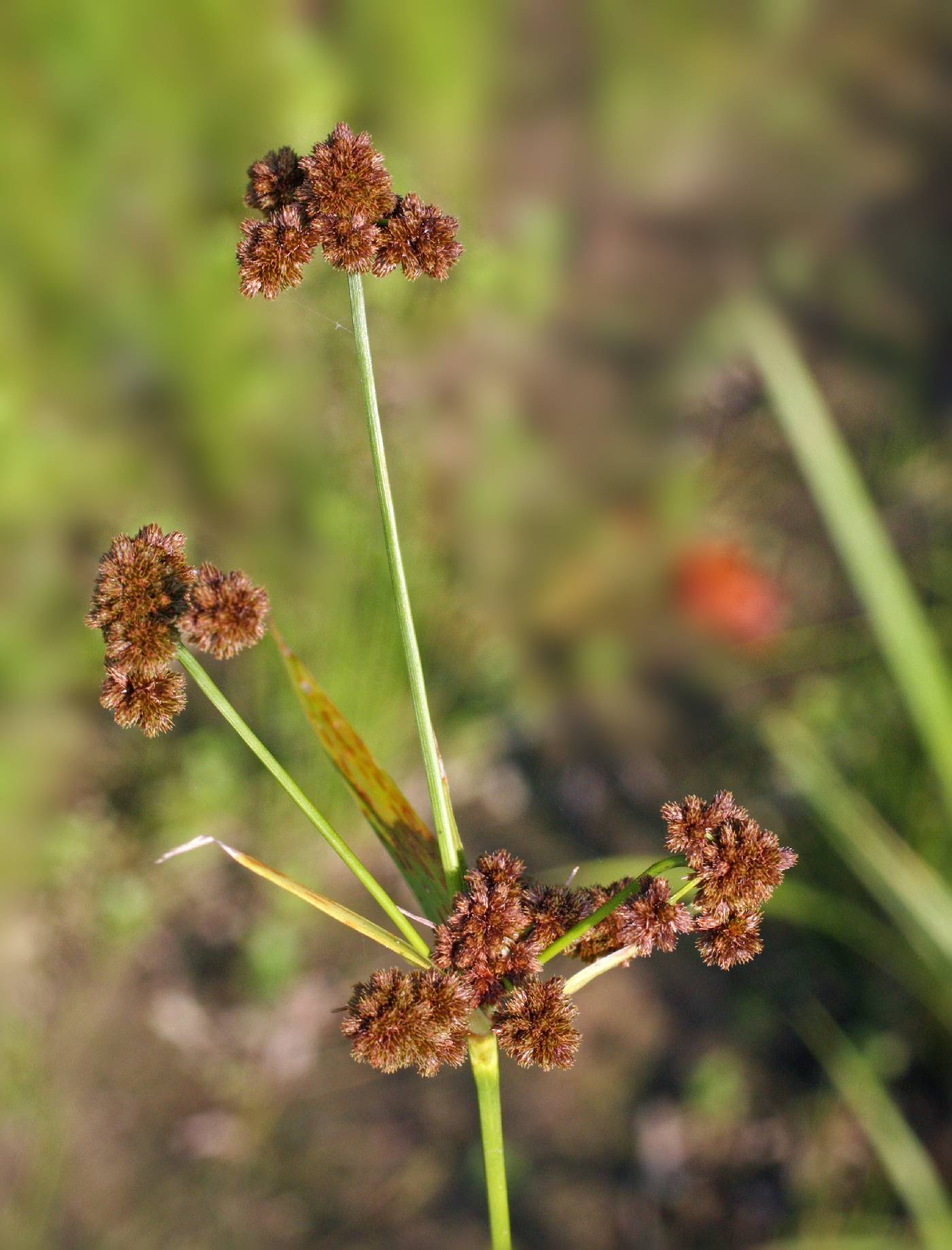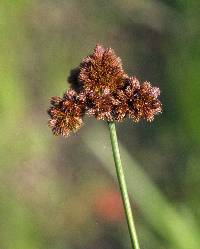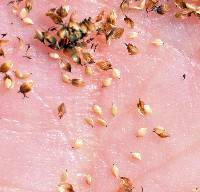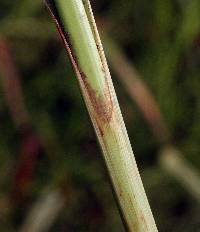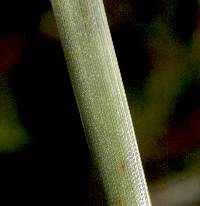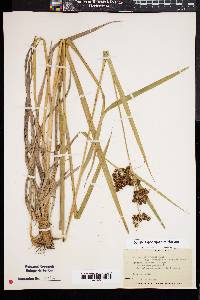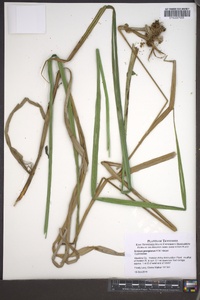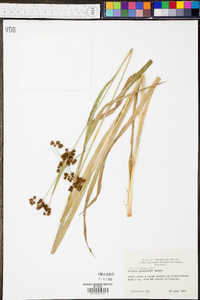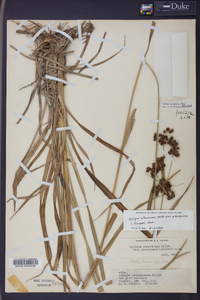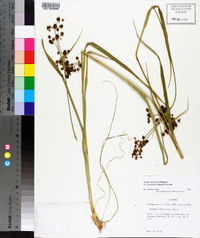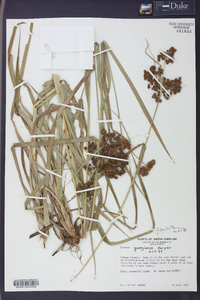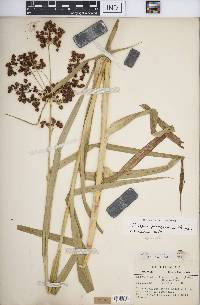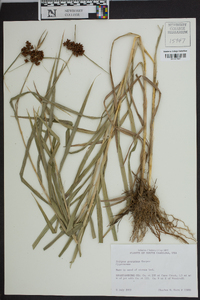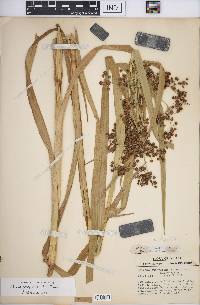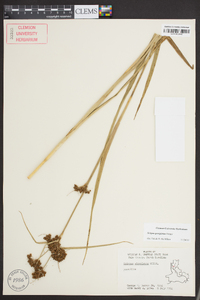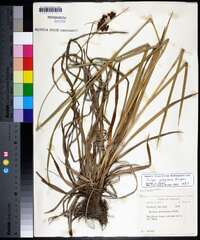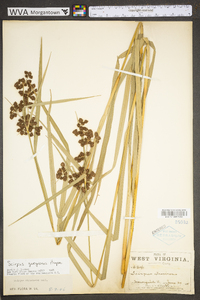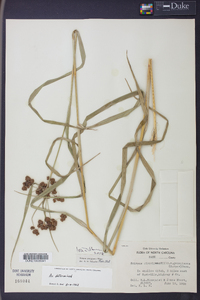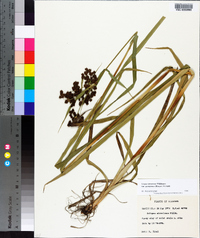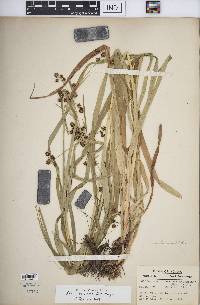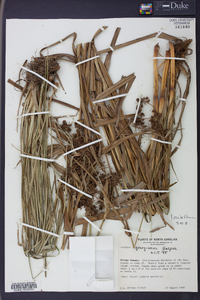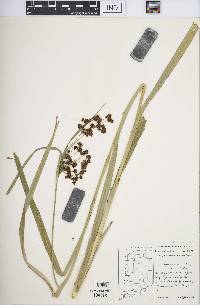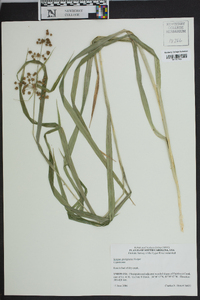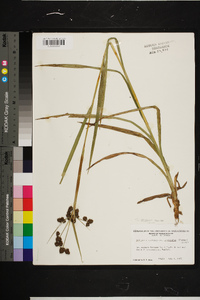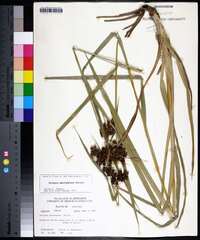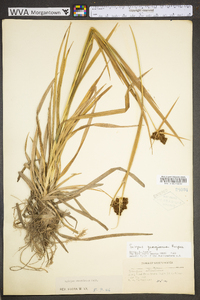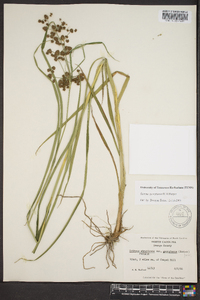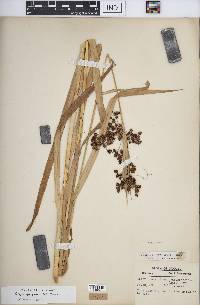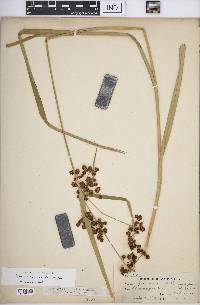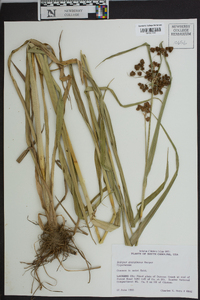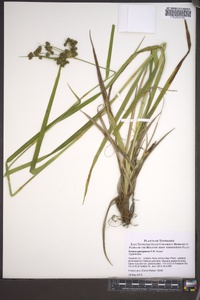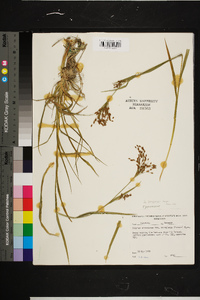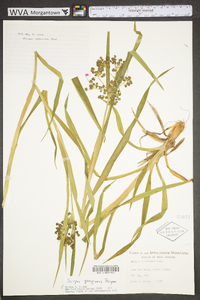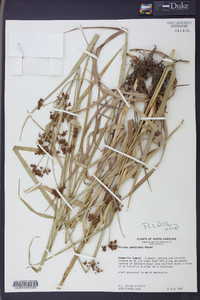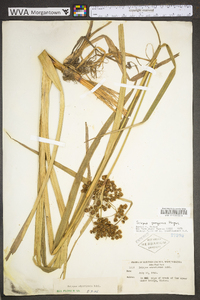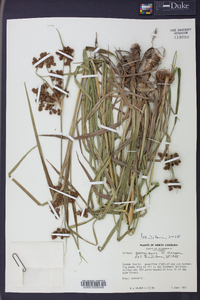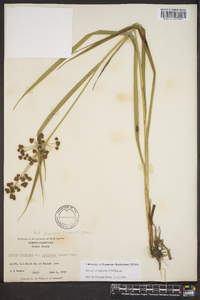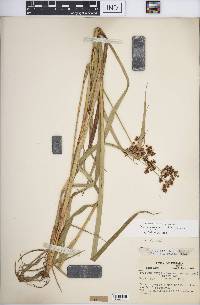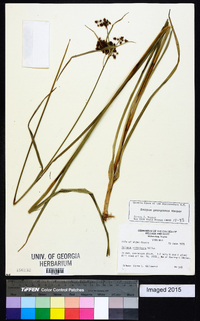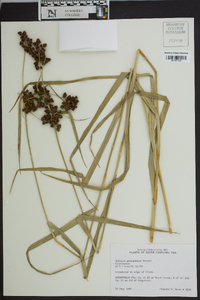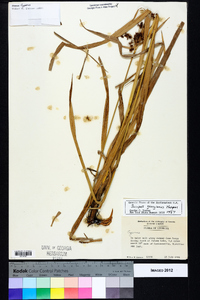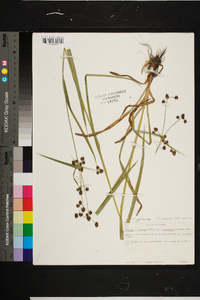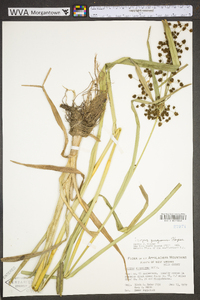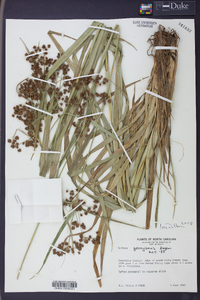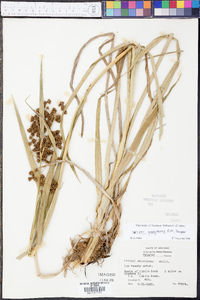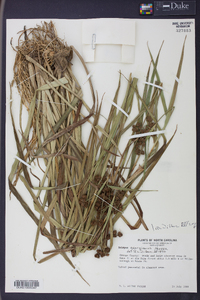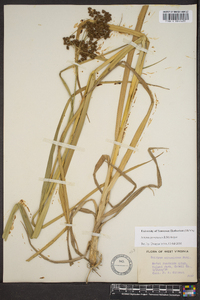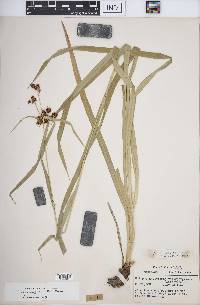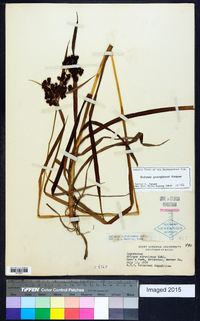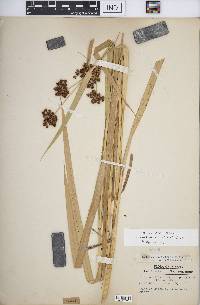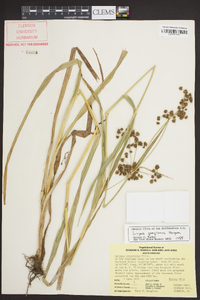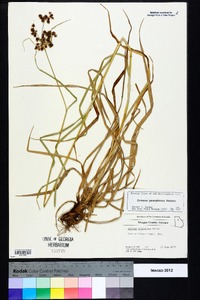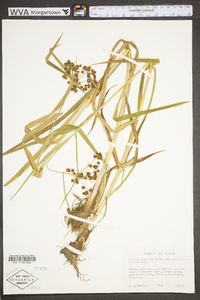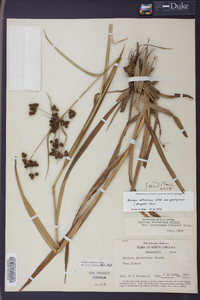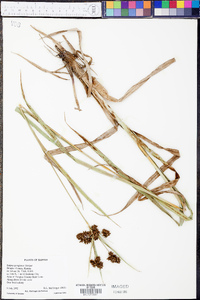Scirpus georgianus
|
|
|
|
Family: Cyperaceae
Georgia Bulrush
|
Plants cespitose; rhizomes short, tough, fibrous. Culms: fertile ones upright or reclining; nodes without axillary bulblets. Leaves 6-12 per culm; sheaths of proximal leaves green or brownish; proximal sheaths and blades with septa few to many, usually not conspicuous; blades 19-50 cm × 6-13 mm. Inflorescences terminal; rays ascending or divaricate (often both in the same inflorescence), proximal branches smooth, distal branches scabrous or scabrellous, rays often bearing axillary bulblets; bases of involucral bracts green, margins brown or at least speckled with red-brown, not glutinous. Spikelets in clusters of 4-35 (largest cluster with 16 or more), spikelets sessile, ovoid, 2-4 × 1-2 mm; scales brown or blackish brown with pale midribs, elliptic, 1-1.8 mm, apex mucronate, mucro 0.1-0.3 mm. Flowers: perianth bristles persistent when present, 0-3, slender, straight or curved, much shorter than (rarely to 0.7 times as long as) achene, smooth or rarely with round-tipped, retrorse teeth near apex, enclosed within scales; styles 3-fid. Achenes pale brown to almost white, elliptic or obovate in outline, plumply trigonous or plano-convex, 0.6-1.2 × 0.4-0.5 mm. 2n = 50, 52, 54. Fruiting late spring-early summer (Jun-Jul). Moist meadows, marshes, ditches; 0-600 m; Ont., P.E.I.; Ala., Ark., Conn., Ga., Ill., Ind., Iowa, Kans., Ky., La., Maine, Md., Mass., Minn., Miss., Mo., Nebr., N.H., N.J., N.Y., N.C., Ohio, Okla., Pa., S.C., Tenn., Tex., Vt., Va., W.Va., Wis.; introduced, New Zealand. In the northern part of its range, Scirpus georgianus occurs in disjunct localities. It is found as far north as Prince Edward Island; it seldom grows in New England. It is unknown from Michigan; it occurs in northern Wisconsin. The species is probably a recent introduction in at least some of these disjunct localities. Most old reports of S. atrovirens var. georgianus from the northeastern United States and eastern Canada are based on specimens of S. hattorianus. The three cytotypes of Scirpus georgianus are identical morphologically; they seem to occur in slightly different habitats (A. E. Schuyler 1976). Scirpus georgianus is distinctive in having the perianth bristles absent or rudimentary (seldom more than 0.2 times as long as achene and usually smooth). Rarely, a few achenes will be found with bristles up to 0.75 times as long as achene and with a few barbs near the tip. Such plants have been confused with S. hattorianus in the past. Scirpus georgianus differs in having fewer bristles (never more than three per achene, and usually only one well developed) and in the bristles either being smooth or having the barbs confined to the extreme tip. In addition, S. georgianus differs from S. hattorianus in having less black pigmentation in the scales (thus the heads tend to appear brownish, not blackish). In Scirpus georgianus, as in other species of Scirpus, the filaments often persist long after the anthers have been shed, and specimens of S. georgianus are sometimes misnamed because the filaments are mistaken for perianth bristles. Only three filaments per flower occur and they are thicker than the bristles and never toothed or barbed. Scirpus georgianus occasionally hybridizes with S. atrovirens and S. hattorianus. Scirpus georgianus, S. flaccidifolius, S. hattorianus, S. atrovirens, and S. pallidus differ only in minute characteristics, and it may be necessary to compare specimens of them in order to make reliable identifications. Despite their close morphologic similarities, their characteristics are reasonably consistent even in areas where they coexist and occasionally hybridize.
Perennial herb with short, tough rhizomes, tufted to 1.5 m tall Leaves: three-ranked, six to twelve per culm. Sheaths of lower leaves green or brownish. Blades 20 cm - 0.5 m long, 6 - 13 mm wide, keeled beneath. Inflorescence: a large, head-like arrangement of spikelets, terminal, one- or two-times branched with many ascending or diverging stalks (which often bear axillary bulblets), subtended by three leaf-like bracts. Bracts green basally, brown or speckled with reddish brown along the margins. Flowers: minute, subtended by a floral scale, lacking sepals and petals, bearing zero to three bristles. Bristles (when present) slender, curved or straight, much shorter than achene, occasionally bearing teeth near the apex, enclosed inside the scales, persistent. Stamens one to three, exserted. Pistil one. Style linear, three-cleft, base persistent. Fruit: a one-seeded achene, light brown to nearly white, about 1 mm long and 0.5 mm wide, elliptic or reverse egg-shaped, plumply three-sided or flat on one side and convex on the other, minutely bumpy. Culm: to 1.5 m long, three-sided, solid. Spikelets: in clusters of four to thirty-five, stalkless, 2 - 4 mm long, 1 - 2 mm wide, egg-shaped. Floral scales spirally arranged, brown to dark brown with a pale midrib, 1 - 2 mm long, elliptic with a rounded apex that bears a tiny point. Similar species: No information at this time. Flowering: June to September Habitat and ecology: Rare in the Chicago Region, where it has been found in wet sandy soil. It has also been found in the open swale of an oak forest, in a low depression, and along an eroded clayey slope. Occurence in the Chicago region: native Etymology: Scirpus comes from the Latin name for a bulrush. Georgianus means "of or from Georgia." Author: The Morton Arboretum From Flora of Indiana (1940) by Charles C. Deam This variety is infrequent in the southern half of the state, becoming rare in our northern counties. The species and variety are distinct in their extremes but they so intergrade that their separation is not entirely satisfactory. …… Indiana Coefficient of Conservatism: C = 3 Wetland Indicator Status: OBL |

